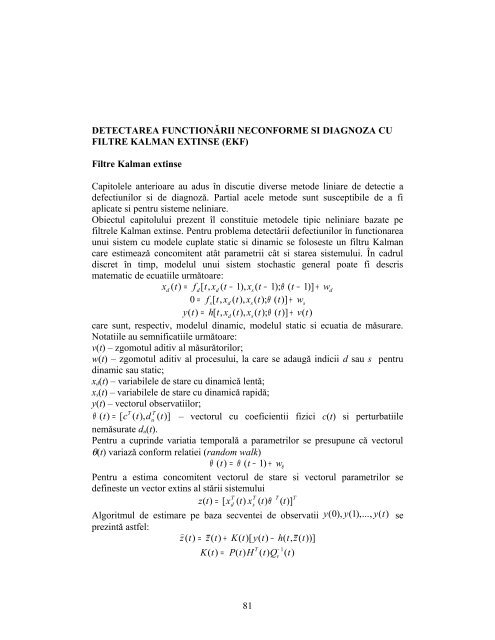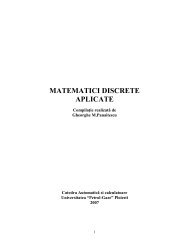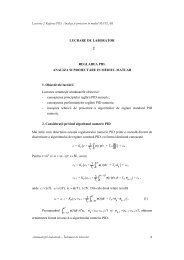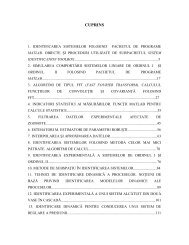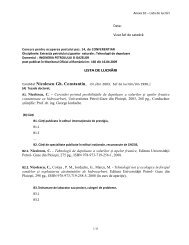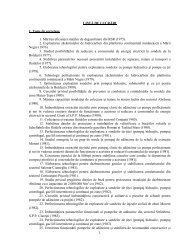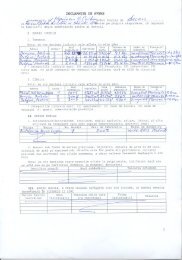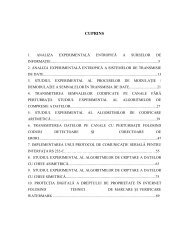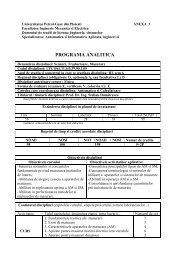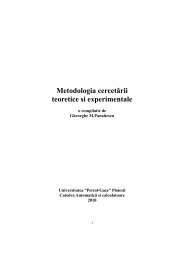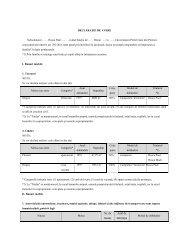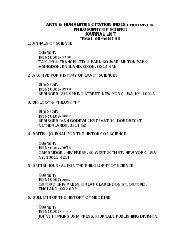Note de curs - Departamentul Automatica, Calculatoare si ...
Note de curs - Departamentul Automatica, Calculatoare si ...
Note de curs - Departamentul Automatica, Calculatoare si ...
Create successful ePaper yourself
Turn your PDF publications into a flip-book with our unique Google optimized e-Paper software.
DETECTAREA FUNCTIONǍRII NECONFORME SI DIAGNOZA CU<br />
FILTRE KALMAN EXTINSE (EKF)<br />
Filtre Kalman extinse<br />
Capitolele anterioare au adus în discutie diverse meto<strong>de</strong> liniare <strong>de</strong> <strong>de</strong>tectie a<br />
<strong>de</strong>fectiunilor <strong>si</strong> <strong>de</strong> diagnozǎ. Partial acele meto<strong>de</strong> sunt susceptibile <strong>de</strong> a fi<br />
aplicate <strong>si</strong> pentru <strong>si</strong>steme neliniare.<br />
Obiectul capitolului prezent îl constituie meto<strong>de</strong>le tipic neliniare bazate pe<br />
filtrele Kalman extinse. Pentru problema <strong>de</strong>tectǎrii <strong>de</strong>fectiunilor în functionarea<br />
unui <strong>si</strong>stem cu mo<strong>de</strong>le cuplate static <strong>si</strong> dinamic se foloseste un filtru Kalman<br />
care estimeazǎ concomitent atât parametrii cât <strong>si</strong> starea <strong>si</strong>stemului. În cadrul<br />
discret în timp, mo<strong>de</strong>lul unui <strong>si</strong>stem stochastic general poate fi <strong>de</strong>scris<br />
matematic <strong>de</strong> ecuatiile urmǎtoare:<br />
xd ( t) = f<br />
d[ t, xd ( t − 1), xs( t − 1); θ ( t − 1)]<br />
+ wd<br />
0 = f<br />
s[ t, xd ( t), xs( t); θ ( t)]<br />
+ ws<br />
y( t) = h[ t, xd<br />
( t), xs( t); θ ( t)] + v( t)<br />
care sunt, respectiv, mo<strong>de</strong>lul dinamic, mo<strong>de</strong>lul static <strong>si</strong> ecuatia <strong>de</strong> mǎsurare.<br />
Notatiile au semnificatiile urmǎtoare:<br />
v(t) – zgomotul aditiv al mǎsurǎtorilor;<br />
w(t) – zgomotul aditiv al procesului, la care se adaugǎ indicii d sau s pentru<br />
dinamic sau static;<br />
x d (t) – variabilele <strong>de</strong> stare cu dinamicǎ lentǎ;<br />
x s (t) – variabilele <strong>de</strong> stare cu dinamicǎ rapidǎ;<br />
y(t) – vectorul observatiilor;<br />
θ ( t) [ c T T<br />
= ( t), du<br />
( t)]<br />
– vectorul cu coeficientii fizici c(t) <strong>si</strong> perturbatiile<br />
nemǎsurate d u (t).<br />
Pentru a cuprin<strong>de</strong> variatia temporalǎ a parametrilor se presupune cǎ vectorul<br />
θ(t) variazǎ conform relatiei (random walk)<br />
θ ( t) = θ ( t − 1)<br />
+ wθ<br />
Pentru a estima concomitent vectorul <strong>de</strong> stare <strong>si</strong> vectorul parametrilor se<br />
<strong>de</strong>fineste un vector extins al stǎrii <strong>si</strong>stemului<br />
T T T T<br />
z ( t)<br />
= [ xd<br />
( t)<br />
xs<br />
( t)<br />
θ ( t)]<br />
Algoritmul <strong>de</strong> estimare pe baza secventei <strong>de</strong> observatii y( 0), y( 1 ),..., y( t)<br />
se<br />
prezintǎ astfel:<br />
<br />
z( t) = z( t) + K( t)[ y( t) − h( t, z( t))]<br />
T<br />
− 1<br />
K( t) = P( t) H ( t) Q ( t)<br />
v<br />
81


